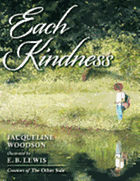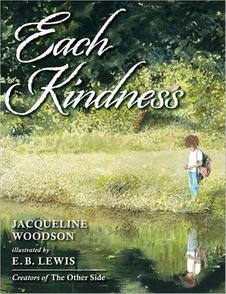
 Jacqueline Woodson and E.B. Lewis, who teamed up for the Caldecott Honor book Coming On Home Soon and The Other Side, deliver a doozy of a picture book about the insidious consequences of bullying. With its lack of resolution, the story of how Chloe shuts out Maya's overtures of friendship haunts Chloe--and readers.
Jacqueline Woodson and E.B. Lewis, who teamed up for the Caldecott Honor book Coming On Home Soon and The Other Side, deliver a doozy of a picture book about the insidious consequences of bullying. With its lack of resolution, the story of how Chloe shuts out Maya's overtures of friendship haunts Chloe--and readers.
Maya shows up at school on a snowy winter morning. Lewis introduces her from a dramatic perspective, as if we are looking up from the floor into Maya's face. She shrinks alongside the principal, who delivers her to narrator Chloe's classroom. "Her coat was open and the clothes beneath it looked old and ragged," observes Chloe. Ms. Albert, their teacher, asks the children to greet Maya, "But most of us were silent." When Maya smiles at Chloe, Chloe moves her chair away. Lewis places readers outside the window looking into the classroom, evoking what Maya must be feeling--the sense of being left out in the cold.
The children can't be older than eight or nine years old, yet they already practice the art of exclusion. Chloe sticks with best friends Kendra and Sophie. They turn down Maya's overtures to play jacks and pickup sticks. On a warm day when Maya wears "a pretty dress and fancy shoes," Kendra calls her "Never New" because even this outfit looks secondhand. The next day, when Maya does not show up at school, Ms. Albert asks each student to think about how kindness ripples out, like dropping a small stone in a bowl of water. "This is what kindness does," the teacher explains. "Each little thing we do goes out, like a ripple, into the world." In Lewis's illustration, the children see themselves in the bowl of water and, as they report the kind things they've done, we can imagine the sense of well-being reflected back to them. All except Chloe, who "couldn't think of anything and passed the stone on." Chloe becomes aware of her ways and wants to make it up to Maya, but it's too late. Lewis depicts Maya's empty desk shrouded in shadow; Maya has moved away.
Woodson perfectly captures that feeling of belonging that comes from turning someone away from the sacred circle--as well as the hollow feeling that follows when you're alone with your conscience. Woodson and Lewis inject a sense of hope through Chloe's self-reflection and sense of remorse. We believe Chloe will do things differently next time. The emotional honesty of Chloe's narrative and Lewis's ability to mirror her mood through her surroundings make this an ideal tool for self-reflection. --Jennifer M. Brown
Shelf Talker: This haunting picture-book tale of bullying demonstrates the subtle erosion of character that cruelty can cause to both victim and tormentor.

